
FOOD & NUTRITION
Art museum adds garden to its palette
TMA grows its own culinary creativity
8/19/2013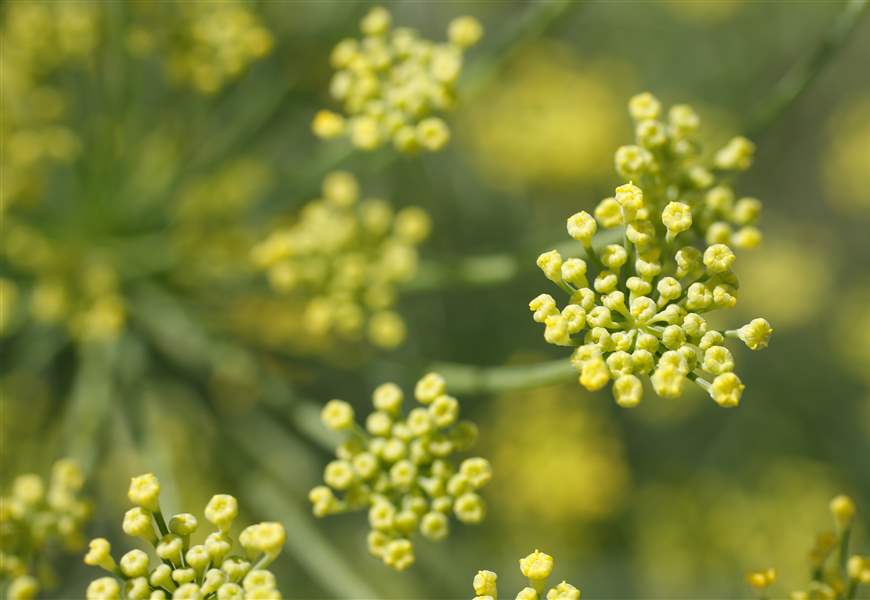
FEA MUSEUM13p Fennel grows in the garden at the Toledo Museum of Art, Tuesday, August 13, 2013. The Blade/Andy Morrison fennel
The Blade/Andy Morrison
Buy This Image
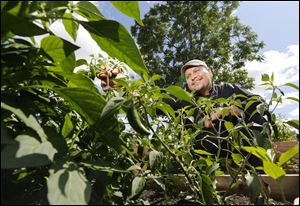
Chef Drew Ruiz picks peppers in the garden at the Toledo Museum of Art.
Chef Drew Ruiz looks out over 20 raised beds of plants near the Toledo Museum of Art, and sees: dinner. And lunch. And special events.
The okra goes in soups. The sage can be used to flavor poultry. When the winter squash ripens, it will lend an unexpected flavor and depth to hummus.
And the rosemary? When Mr. Ruiz sees the rosemary, he thinks about steeping it in heavy cream for a ganache, making a balsamic vinegar reduction, pairing it with fresh strawberries, and serving it all as part of a cake
That’s a cake with rosemary and balsamic vinegar in it, and it all begins with rosemary fresh from the chef’s garden.
Mr. Ruiz, 36, is the art museum’s executive chef. The garden, which is new this year, was his idea.
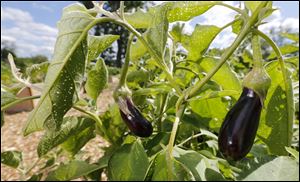
Eggplant growing.
“I kept seeing more and more need in our community for unprocessed foods. I figured the best way to do that is to take charge of the source of some of this food,” he said.
So, using land owned by the museum, he set up the garden. There was only one problem.
“I’ve never gardened before in my life. I went from zero to 100, and hit the ground running,” he said.
Fortunately, he has received advice and help from such organizations as the Toledo Botanical Garden, and Toledo GROWs, which also has a garden on adjacent land owned by the museum.
Even with this assistance, there is the occasional mistake. He neglected to provide stakes or cages to keep the tomatoes climbing high, so the plants have flopped over to the ground.
“This is a huge learning curve for me,” he said.
But it is obvious he thinks the results are worth it. He can use the freshest possible produce in the meals he prepares at the museum. At the café, the herbs and vegetables are likely to turn up in the soups of the day, the chef’s special, and the daily burger special. The garden is not large enough to supply produce for the regular menu in the amounts he would need to maintain consistency, so it is mainly being used for special events such as corporate meetings or weddings.
“The museum has given me the freedom to try new things, to express myself as an artist,” he said. That means everything from corning his own beef to, well, making a cake with rosemary and balsamic vinegar.
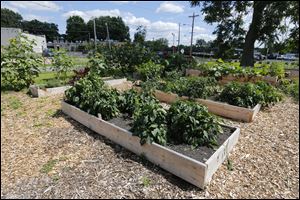
Raised garden beds at the TMA.
When he was growing up in Poulding County, near the Indiana state line, he hated it when his parents wanted him to help in their garden. Now his parents help him in his, along with his partner, Tracy Plumb (she is also a trained chef; they met in culinary school), and his daughters, aged 11, 7, and 6 — the 2-year-old is still too young. What he called “a wide-ranging group in Toledo, from master gardeners to multi-faith volunteers” also provides valuable aid.
The unusually rainy summer has proved beneficial for all the museum’s gardeners, especially because there is no water line to the garden. When the plants do need extra water, Mr. Ruiz and his volunteer helpers have to carry it from a cistern in five-gallon buckets.
He is also insistent on refraining from using any kind of chemical, fertilizer, or pesticide — “just really good soil,” he said.
You can’t get more organic than that, but it does leave the plants vulnerable to insects, animals, and the occasional two-legged thief. Even moths, flitting decoratively in the sunlight from plant to plant, are a cause for headaches.
“Oh, those moths. They lay eggs, and when the larvae hatch, they love the melons and squash plants,” he said.
At this point in the summer, the cucumbers and kohlrabi have all been harvested, their plants removed, and their beds reseeded with a winter crop of beets and rutabagas. The beets have him most excited (“I’m a huge fan of beets”), along with the heirloom petite carrots in all shapes, sizes, and colors.
Earlier this year, he held a cooking demonstration in which he used the beet greens to make an unusual sushi. He blended together the greens with smoked bacon, onions, shallots, and a white wine reduction to create a sauce that accompanied sushi made with chicken in it and a coating of panko and toasted waffle crumbs. It was, he said, his take on the southern dish of chicken and waffles.
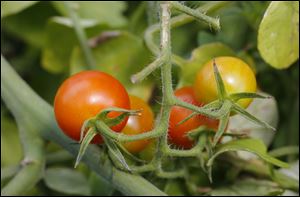
Tomatoes growing at the TMA.
To make best use of all the fresh herbs and vegetables, his kitchen has been turning out large amounts of grilled and chilled vegetables. But he is also thinking about the colder months, when the produce will no longer be there. So he is preserving what he can by pickling it, canning it, and confiting it.
“All the things my mother did when I was growing up that I wanted nothing to do with. Now I want to do it,” he said.
“I’m looking to preserve what is best right now at the height of its season, the height of the flavor, with the hopes of releasing that flavor in November, with the hope of turning somebody’s day around. Everyone deserves their happiness.
“That’s what we’re trying to capture in the kitchen — the love of our craft, the love we have for an institution, and the love we have for our community and our patrons.”
Contact Daniel Neman at: dneman@theblade.com or 419-724-6155.
RECIPES
Rosemary Baba Ghanouj
- 2 pounds eggplant
- ¼ cup extra-virgin olive oil
- 1 clove of garlic
- 1 stalk rosemary
- 2 teaspoons fresh parsley, leaves only, plus more if needed
- ¼ cup tahini
- Salt and pepper, to taste
- Zest and juice of ½ lemon
Preheat oven to 350°.
Poke several holes in the eggplant to allow steam to escape, and place on a baking sheet. Roast 30-45 minutes, until soft. Meanwhile, pour oil into a shallow pan over medium heat; add garlic and rosemary. Cook until garlic turns golden brown. Discard rosemary.
Remove eggplant and allow to rest 15 minutes or until cool enough to handle. Slice in half and scoop eggplant pulp into food processor, along with garlic and parsley. While processor is running, slowly pour in aromatic oil. Mix in tahini. Add salt, pepper, lemon juice, zest, and more parsley to find a balance of saltiness, acidity, and herbal flavors.
Yield: 2 cups; Source: Drew Ruiz
Spicy Garden Gazpacho
- 2 pounds tomatoes
- 1 cucumber
- ½ cup diced bell pepper
- ½ cup diced onion
- 1 small jalapeño or serrano pepper, seeded and diced
- 2 cups bloody mary mix
- 1 clove of garlic, minced
- ¼ cup extra-virgin olive oil
- Zest and juice from 1 lime
- 2 teaspoons balsamic vinegar
- 2 teaspoons Worcestershire sauce
- 1 tablespoon strong horseradish
- ½ teaspoon cumin
- 1 piece stale bread
- Salt and pepper, to taste
Set a medium pot of water to boil on the stove. With a paring knife, cut a small "X" in the top and bottom of the tomatoes. Fill a large bowl with cold water and ice. Drop the tomatoes into the boiling water (you may need to do this in batches) and boil 20-30 seconds. Remove with a slotted spoon and immediately place the tomatoes into the ice bath. When cool, pull off the skins. Cut the tomatoes into quarters, cut out the seeds, and dice the tomatoes.
Peel the cucumbers and cut in half, lengthwise. Scoop out the seeds with a spoon. Cut in half lengthwise again, and dice. In a large bowl, mix together the diced tomatoes, diced cucumber, bell peppers, onion, and hot pepper, along with a dash of salt.
In a blender or food processor, add ½ cup of the diced vegetables, bloody mary mix, garlic, olive oil, lime juice and zest, balsamic vinegar, Worcestershire sauce, horseradish, cumin, and bread, and purée until smooth. Add all the ingredients back together and season to taste with salt and pepper.
Yield: 4-6 servings; Source: Drew Ruiz